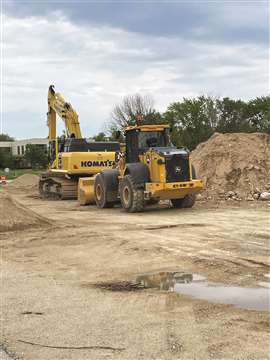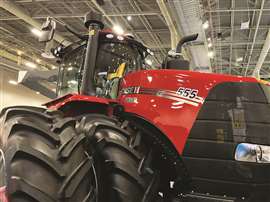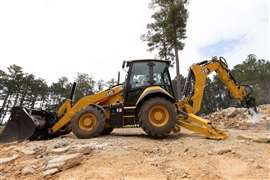Forecast 2024: Challenges lie ahead, but optimism is warranted
27 September 2023
AEM: Technologies present growth opportunity for ag and construction
As the construction and agriculture industries continue to navigate and embrace change, there will be no shortage of challenges on the horizon. However, along with those challenges come a multitude of opportunities.
AEM members report demand for products across both industries has softened as of late. However, particularly in construction, investments in infrastructure, energy and utilities point to better days ahead. And, perhaps more importantly, our latest data suggests optimism – both in the short term and long term – is (and should be) prevalent.
Outlook for construction
 Infrastructure investment will be a key driver for construction growth. (Photo: KHL staff)
Infrastructure investment will be a key driver for construction growth. (Photo: KHL staff)
When looking specifically at construction, numerous equipment technologies will fundamentally transform the way the industry operates, which necessitates an entirely new approach. The transition is already underway – with changes to how buildings are designed, how equipment operates, how organizations function and how workers approach their respective roles and responsibilities.
A variety of alternative power solutions also will be considered and implemented as the industry looks to reduce its carbon footprint, each bringing along with it its own unique challenges. The construction industry is nothing but resilient though, and it will continue to face challenges head on and take advantage of opportunities in front of it.
It’s long been said the industry is slow to adapt to, and adopt, technology. That’s not entirely the case, however. The men and women who support the industry want to do their jobs efficiently and effectively, and they take pride in their work. New and cutting-edge construction equipment technologies allow them to do their work faster, better and safer. And, as technology is adopted, its benefits to people, planet and productivity will be validated, driving wider industry adoption. Finally, manufacturers continue to invest in technology, focusing on the needs of their customers. The construction industry will soon see proven benefits, along with an even greater return on their investment.
Ultimately, the construction industry is – and should be – optimistic in both the near term and long term. The Infrastructure Investment and Jobs Act (IIJA) will continue to be a key driver for construction growth, with hundreds of billions of dollars allocated for infrastructure, energy and utilities. Meanwhile, the CHIPS and Science Act and the Inflation Reduction Act are driving spending in the industrial and manufacturing sector. This growth and momentum have even more potential, especially as the industry embraces technology to improve productivity and performance.
Outlook for agriculture
From an ag industry perspective, America’s farmers have cemented their legacy as the most essential of essential workers. Their willingness to assume enormous levels of risk and work tirelessly to help secure a critical supply chain is unparalleled. Plus, they do it all while managing millions of acres of land and preserving vital natural resources.
Essentially, everything hinges on where a farmer can improve their efficiency the most and, in turn, see the greatest possible return on investment (ROI). With input costs continuing to rise, the best ways for a farmer to respond and continue to reap the rewards of strong commodity prices is to operate on those margins and find wins wherever possible.
 Technology, and especially data, have potential to provide such tremendous value and benefits to the agriculture industry. (Photo: KHL staff)
Technology, and especially data, have potential to provide such tremendous value and benefits to the agriculture industry. (Photo: KHL staff)
Technology, and even more specifically data, provides such tremendous value and benefits. As farmers are looking for ways to minimize inputs (and in turn costs), while still increasing yields, technology provides the answer. It can be an herbicide, fertilizer application or the feed being given to a dairy cow. The data insights that technology provides allow farmers to make better, more informed decisions for their operation and lead to more effective execution. We’re even seeing the emergence of technologies, such as targeted spray systems, that are able to make decisions in real time to reduce inputs in the field.
Ultimately, the biggest deciding factor in a farmer’s willingness to adopt new technology is whether or not it will actually work for them (and, perhaps more importantly, when they will see a return on their investment). Farms are a business and, more times than not, a farmer is ultimately more than likely willing to try something new if there is a solid business case to be made. However, most farms operate on the margins and don’t always have three to five years to wait and achieve an ROI.
In both the near and long term, farmers and the ag industry as a whole are in a really great spot. In the wake of the COVID-19 pandemic, people are starting to realize now more than ever how fragile our food supply can be at this point. As a result, society possesses a greater appreciation for the men and women along that supply chain who work to make sure everyone
 Sara Fueling, senior director of Construction, AEM
Sara Fueling, senior director of Construction, AEM
has nutritious food available to them. That’s why there’s reason for optimism in the near term.
Looking farther out, there is even more cause for optimism because of the role that agriculture can play in our journey to being more sustainable. Agriculture has a huge role to play in addressing a number of the sustainability goals that exist around the world today. The important part will be how the industry tells its story and lends its voice to those conversations.
The bottom line
The construction and ag industries are always changing. Yet, some familiar trends always remain. Technology continues to evolve with time. Inflation and supply chain issues are significant concerns, as is the ability to attract, train and retain the workforce of tomorrow.
Both contractors and producers are having to work harder (and smarter) than ever before to address and counteract some of these challenges. Possessing a sound strategy and following proven best
 Austin Gellings, director of Agriculture, AEM
Austin Gellings, director of Agriculture, AEM
practices can help – and, perhaps more importantly, yield lasting, positive results.
So, as both industries continue to navigate short-term challenges and uncertainty, the projected increase in investments should offset concerns about the long-term outlook for construction and ag. Ultimately, that should lead to sustained growth in the not-too-distant future.
Sara Feuling is the senior director of Construction for the Association of Equipment Manufacturers (AEM), while Austin Gellings is the association’s director of Agriculture. For more information on AEM and its ag and construction sectors, visit aem.org.
POWER SOURCING GUIDE
The trusted reference and buyer’s guide for 83 years
The original “desktop search engine,” guiding nearly 10,000 users in more than 90 countries it is the primary reference for specifications and details on all the components that go into engine systems.
Visit Now
STAY CONNECTED




Receive the information you need when you need it through our world-leading magazines, newsletters and daily briefings.
CONNECT WITH THE TEAM












